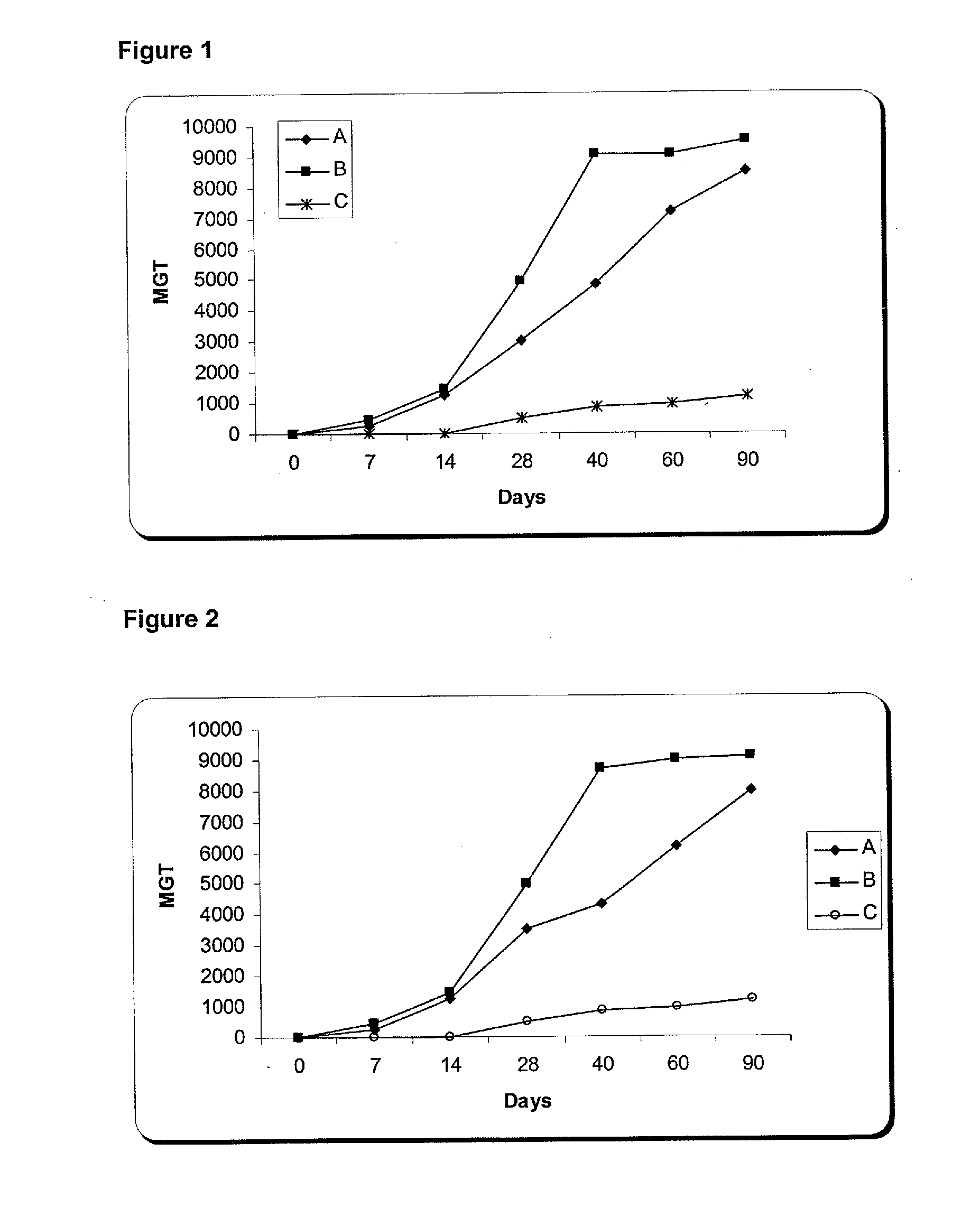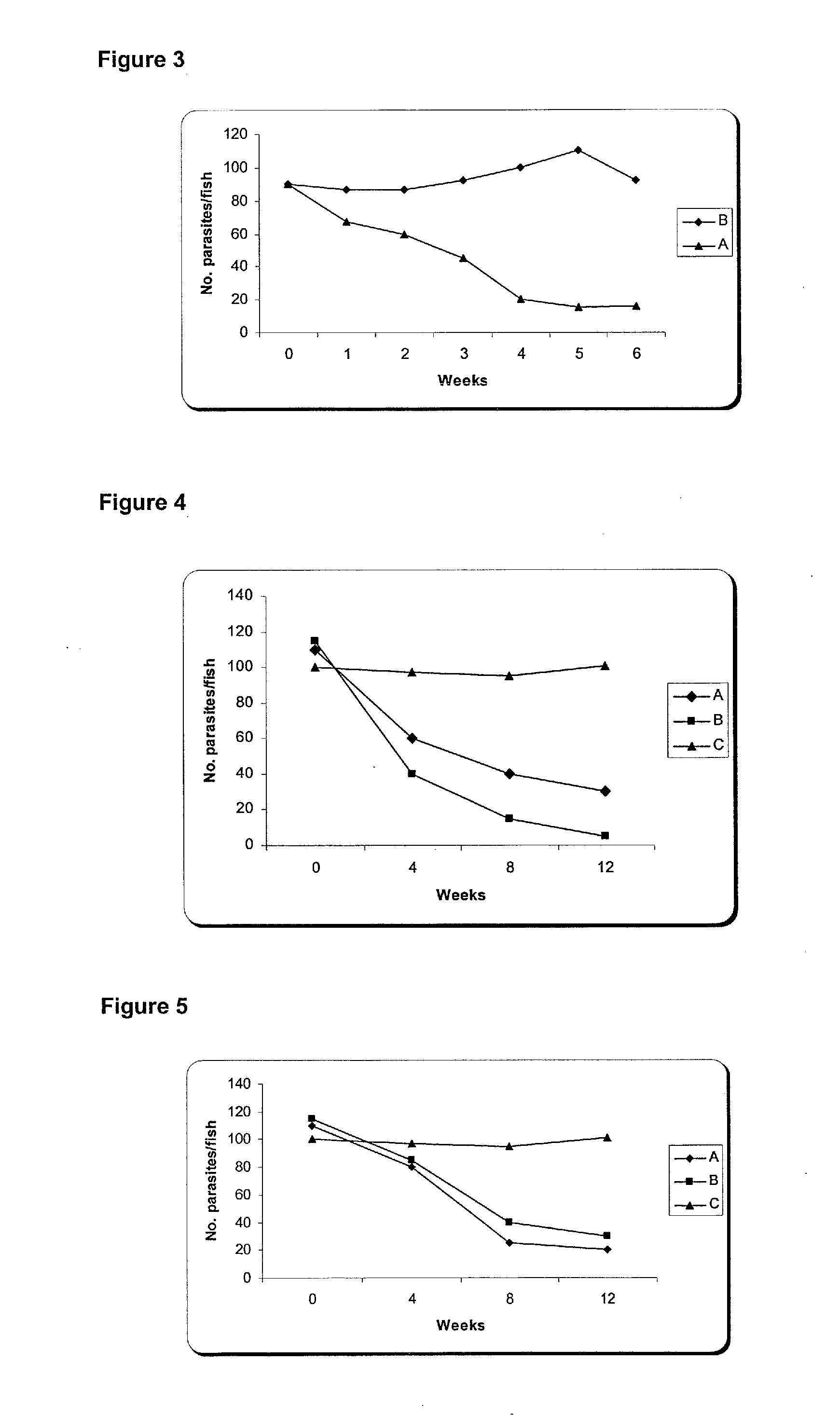Nucleic Acid and Amino Acid Sequences, and Vaccine for the Control of Ectoparasite Infestations in Fish
a technology of amino acid sequences and ectoparasites, applied in the field of aquatic biotechnology, can solve the problems of difficult operation of immersion baths, high cost, and significant effect on fish growth, and achieve the effect of not being effective in all sea lice development stages
- Summary
- Abstract
- Description
- Claims
- Application Information
AI Technical Summary
Benefits of technology
Problems solved by technology
Method used
Image
Examples
example 1
Isolation and Cloning of the MY32 Gene
[0034]The coding sequence for the MY32 polypeptide was obtained by PCR from cDNA of Caligus rogercresseyi, using degenerate oligonucleotides designed from previously reported sequences for subolesin / akirin in different arthropods. The oligonucleotides were:
Oligonucleotide that hybridyze with 5′ fragment:(SEQ ID NO: 8)ATG GC(T / C) TG(T / C) GC(T / C / G / A) AC(T / C / A / G) (T / C)T(T / C) AA(A / G)(SEQ ID NO: 9)ATG GC(T / C) TG(T / C) GC(T / C / G / A) AC(T / C / A / G) (T / C)T(A / G) AA(A / G)(SEQ ID NO: 10)ATG GC(G / A) TG(T / C) GC(T / C / G / A) AC(T / C / A / G) (T / C)T(T / C) AA(A / G)(SEQ ID NO: 11)ATG GC(G / A) TG(T / C) GC(T / C / G / A) AC(T / C / A / G) (T / C)T(A / G) AA(A / G)Oligonucleotide that hybridyze with 3′ fragment:(SEQ ID NO: 12)TT(A / C)AC(A / G)AA(A / C / G / T)G(T / C)(A / G)TC(A / G)TA(C / T)TG(C / T)TC(SEQ ID NO: 13)TT(G / T)AC(A / G)AA(A / C / G / T)G(T / C)(A / G)TC(A / G)TA(C / T)TG(C / T)TC
[0035]The amplified DNA was cloned into a commercial pGEM Teasy vector (Promega) and it was sequenced with Thermo Sequenase Premixed cycle Sequence...
example 2
Construction of Pichia pastoris Expression Vector Containing the Coding Sequence for MY32 Polypeptide, Transformation of MP36 Strain and Protein Expression
[0036]The my32 gene was amplified by PCR with specific oligonucleotides. These specific oligonucleotides incorporated a histidine tail to facilitate the protein immunodetection and purification. The PCR product was treated with T4 polynucleotide kinase enzyme to phosphorylate the gene ends and facilitate its cloning into the expression vector. The expression vector pPS7 was enzymatically digested with Nco I restriction endonuclease, treated with nuclease S1 and phosphatase alkaline to blunt and desphosphorylate the ends. The recombinant plasmid obtained was named pPS7-my32.
[0037]Prior to transformation, the plasmids were linearized with Pvu II restriction enzyme. The P. pastoris strain MP36 was transformed by electroporation with the recombinant expression vector. This strain is an auxotrophic his3 mutant which acquired the His ph...
example 3
Construction of my32 DNA Expression Vector in Eukaryotic Cells for Naked DNA Vaccine
[0039]The gene my32 was excised from pGEM T easy (Promega) by digestion with EcoR I. The insert was purified by QiaQuick kit (Qiagen, Hamburg, Germany) and ligated to pVAX vector (Invitrogen) previously digested with EcoR I. Recombinant DNA employed in immunization experiments was purified by Endo Free Plasmid Mega kit (Qiagen, Hamburg, Germany).
PUM
| Property | Measurement | Unit |
|---|---|---|
| body weight | aaaaa | aaaaa |
| weight | aaaaa | aaaaa |
| average body weight | aaaaa | aaaaa |
Abstract
Description
Claims
Application Information
 Login to View More
Login to View More - R&D
- Intellectual Property
- Life Sciences
- Materials
- Tech Scout
- Unparalleled Data Quality
- Higher Quality Content
- 60% Fewer Hallucinations
Browse by: Latest US Patents, China's latest patents, Technical Efficacy Thesaurus, Application Domain, Technology Topic, Popular Technical Reports.
© 2025 PatSnap. All rights reserved.Legal|Privacy policy|Modern Slavery Act Transparency Statement|Sitemap|About US| Contact US: help@patsnap.com


